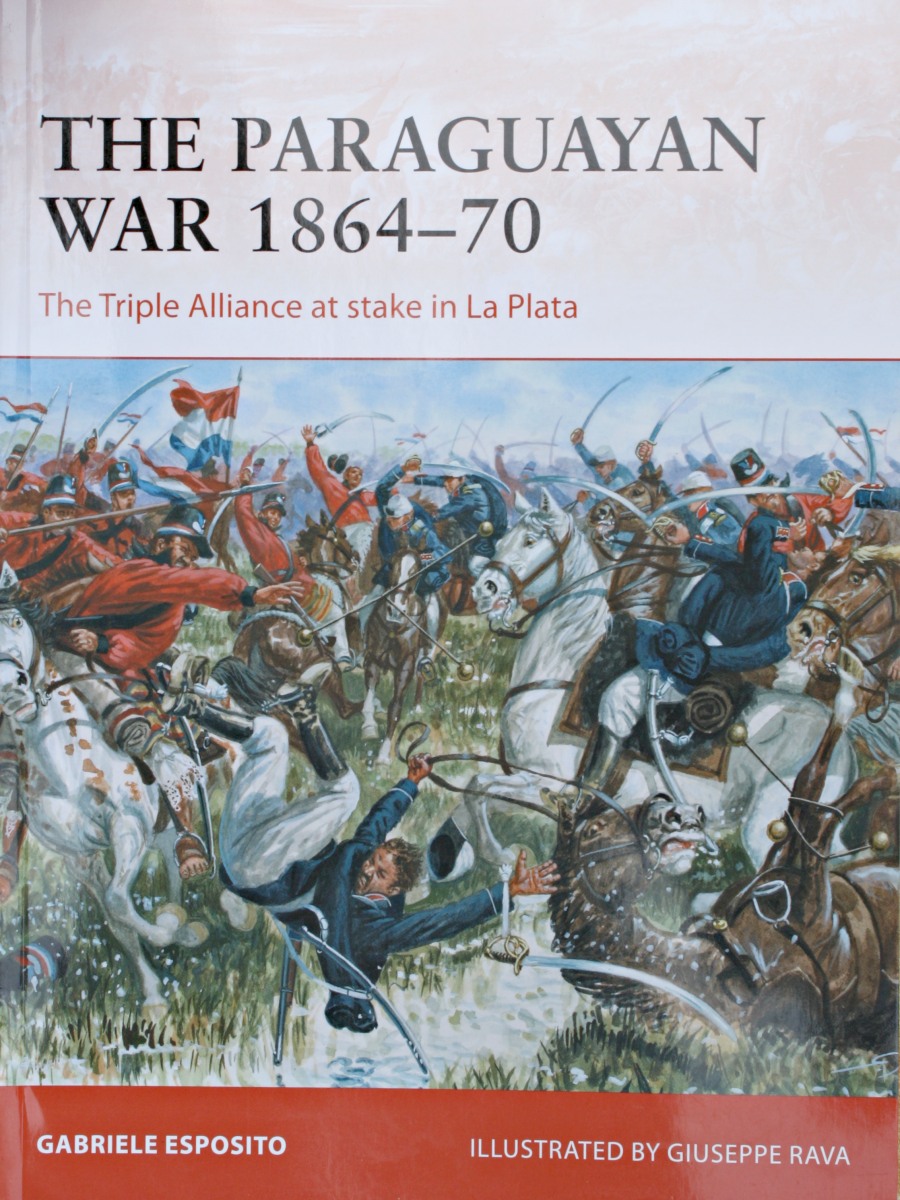The Paraguayan War 1864-70. The Triple Alliance at stake in La Plata. Campaign 342.
Gabriele Esposito is an Italian student of military history with an interest in 1800s Latin America. Giuseppe Rava contributed three two-page and a smaller paintings in color of the pivotal battles of this war.
Osprey’s Campaign 342 covers the war that involved the eastern countries of South America as they joustled their own revolutions with military actions against their neighbors, setting the stage for current countries and boundaries. Like other Osprey Campaign books, this issue is 96 pages (not counting the front/back covers) –enough for a discussion on the war and its aftermath.
This book provides twelve maps of the theatre, individual battles and subsets of battles. Sixteen B&W and twelve color photographs, 28 B&W and 12 color illustrations, three Tables and a two-page Chronology compliment the text. Almost every page has some sort of visual to look at, giving a better feel for what is was like to have fought in this war.
Sections are devoted to:
- Origins of the campaign
- Chronology
- Opposing commanders
- Opposing forces
- Opposing plans
- The Campaign (battles)
- Aftermath
- Battlefields Today
- Bibliography & Further Reading
- Index
Osprey Campaign books follow this organization.
This war was preceded, and coexisted, with other wars that plagued the four countries involved: Argentine, Brazil, Paraguay and Uruguay. These wars were briefly examined as they set up the war that finally settled what we know today as South America (at least the southern half). Brazil was an Empire, recently departed from a waning Portuguese presence. Argentina was wracked by rapid exchanges of revolutions and governments. Uruguay and Paraguay were in danger of being swallowed by their larger neighbors, and became belligerent just to survive. This was a time of big egos in charge, poor intel, and greed. This was also a turning point in how wars were fought, coming when the American Civil War was winding down. As such, new weapons and technologies were used, changing battlefields forever.
The history of this area of the world was chaotic to say the least, and if one blinked, there might be a new government. Nevertheless, Paraguay, being completely landbound, was at a disadvantage and tried to take by force a seashore. Obviously it did not work, and what transpired is chilling for the loss of life, both in vicious battles and in disease and starvation. Many lessons on how not to conduct a battle, campaign or war abound. The Aftermath section put perspective into these travails by showing how these countries forged ahead as (usually) peaceful neighbors since then.
The settings for the major battles and campaigns are well done. One wonders about the mindsets of the people involved, especially of the families of the troops that never returned. I would have liked to have seen more about how normal people lived under those conditions, but this was a campaign book by design.
Summary
This war was large and occurred during a pivotal time of rapid change in warfare, and was important for geohistory, marking the end of colonial eras and a path to modernity. Historically, this war was very confused, but ably tied together by Gabriele Esposito. The results are worth reading about to understand what South America went through to get to its current status. Like other Osprey Campaign books, this is a relatively quick read but lasts long enough to satisfy.
Thanks to Osprey Publishing for the review copy and IPMSUSA staff for delivering the book and publishing the review.

Reviewer Bio
Luke R. Bucci, PhD
Luke built all kinds of models starting in the early '60s, but school, wife Naniece, and work (PhD Clinical Nutritionist) caused the usual absence from building. Picked up modeling to decompress from grad school, joined IPMSUSA in 1994 and focused on solely 1/700 warships (waterline!) and still do. I like to upgrade and kitbash the old kits and semi-accurize them, and even scratchbuild a few. Joined the Reviewer Corps to expand my horizon, especially the books nobody wants to review - have learned a lot that way. Shout out to Salt Lake and Reno IPMSUSA clubs - they're both fine, fun groups and better modelers than I, which is another way to learn. Other hobbies are: yes, dear; playing electric bass and playing with the canine kids.








Comments
Add new comment
This site is protected by reCAPTCHA and the Google Privacy Policy and Terms of Service apply.
Similar Reviews